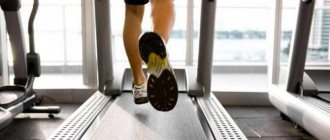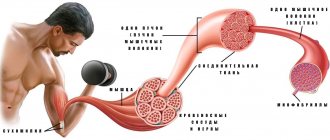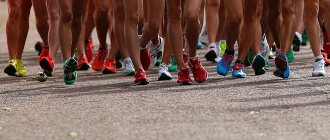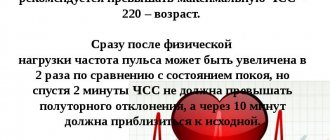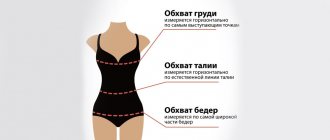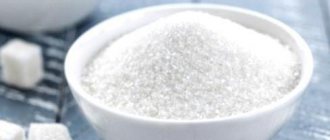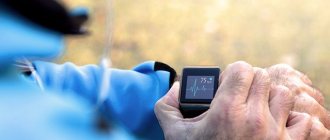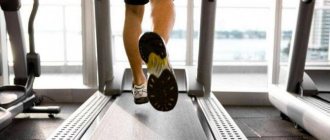You can count the pulse by pressing the artery, which is located as close as possible to the surface of the body - on the wrist, elbow, neck (carotid artery), under the knee. Normally, an adult's heart rate should be between 60-80 beats per minute, but under certain circumstances it can be increased to 130-150 - for example, after exercise, when drinking coffee or alcoholic beverages, if a person constantly smokes, etc. Further.
It would be considered correct to measure the pulse at rest, when a person is in a sitting position and has been in a relaxed state for 2-5 minutes. If athletes need heart rate monitoring to determine the maximum possible load, then measurements should be taken before, during, and 1-2 minutes after training.
Basic concepts about heart beats
Heart rate is a physiological characteristic that reflects the normal rhythm of the heart, widely used in both the medical field and professional sports. Heart rate is determined by a number of many factors and can fluctuate significantly due to various reasons, but it is important that these indicators do not exceed established limits. A decrease or increase in the heart rate in a pathological form often leads to aggravation of diseases of the endocrine, nervous and cardiovascular systems, and can also cause serious health consequences.
What does heart rate depend on?
The pulse at rest does not always correspond to normal values. Sometimes the heart contracts less often or more often; the cause may be temporary physiological phenomena. For example, an increased rhythm is observed in women during menopause, and a decreased rhythm is observed after taking certain medications.
If your heart rate is regularly outside the normal range, this indicates health problems.
Factors affecting heart rate:
- Fitness level. Athletes have a lower rate than untrained people.
- Lack of fluid in the body. Dehydration leads to intense cardiac activity.
- Air temperature. When it's hot, blood vessels dilate and the heart rate increases. In cold weather it's the opposite.
- Stress and emotions. Excitement and prolonged nervous tension lead to an increase in heart rate.
- Excess weight. Overweight people have a higher heart rate than normal.
- Bad habits. With smoking and alcoholism, the heart quickly wears out and arrhythmia appears.
- Device for measuring human pressure
- Cholesterol plaques
- Signs of appendicitis in children
What is the difference between heart rate and pulse?
Most people think they are the same thing. But it is not so. Heart rate reflects the number of contractions made by the heart, and specifically by the ventricles (lower sections), in one minute. Pulse rate, or pulse, is the number of arterial dilations during the heart's ejection of blood, also in one minute. As blood flows through the vessels during heart contractions, it creates a bulge in the arteries that can be identified by touch. Heart rate and pulse may be equal, but this is typical only for a healthy person. For example, with rhythmic disturbances, the heart begins to contract erratically. When it contracts twice in a row, the left ventricle does not have time to fill with blood. The second contraction, therefore, occurs with an empty ventricle, and blood is not ejected from it into the peripheral vessels and into the aorta. In this regard, a pulse will not be felt in the arteries, although cardiac contraction occurs. During atrial fibrillation and a number of other pathologies, a discrepancy between the pulse rate and heart rate is observed. This phenomenon is called pulse deficiency. In such cases, it becomes impossible to determine heart rate through pulse measurements. This can only be done by listening to heartbeats, for example, using a phonendoscope. It is important to know how to measure heart rate correctly.
General characteristics of heart rate and blood pressure
Heart rate:
Heart rate (HR) depends on many factors, including age, gender, body position, and environmental conditions. It is higher in a vertical position compared to a horizontal position, and decreases with age. Resting heart rate lying down is 60 beats per minute; standing-65. Compared to a lying position, in a sitting position, heart rate increases by 10%, while standing by 20-30%. On average, heart rate is about 65 per minute, but there are significant fluctuations. For women, this figure is 7-8 higher.
Heart rate is subject to daily fluctuations. During sleep, it is reduced by 2-7, within 3 hours after eating it increases, especially if the food is rich in proteins, which is associated with the flow of blood to the abdominal organs. Ambient temperature affects heart rate, which increases linearly with effective temperature.
In trained individuals, the resting heart rate is lower than in untrained individuals and is about 50-55 beats per minute. Physical activity leads to an increase in heart rate, which is necessary to ensure an increase in cardiac output, and there are a number of patterns that allow this indicator to be used as one of the most important when conducting stress tests.
There is a linear relationship between heart rate and work intensity within 80-90% of the maximum load limit.
During light physical activity, the heart rate initially increases significantly, but gradually decreases to a level that remains unchanged throughout the entire period of stable exercise. With more intense loads, there is a tendency for heart rate to increase, and with maximum work it increases to the maximum achievable. This value depends on training, age, gender and other factors. In trained people, the heart rate reaches 180 beats/min. When working with variable power, we can talk about a contraction frequency range of 130-180 beats/min, depending on the change in power.
The optimal frequency is 180 beats/min under different loads. It should be noted that the work of the heart at a very high contraction frequency (200 or more) becomes less efficient, since the filling time of the ventricles is significantly reduced and the stroke volume of the heart is reduced, which can lead to pathology (V.L. Karpman, 1964; E.B. Sologub, 2000).
The heart is a muscular pump whose function is to constantly move blood and the oxygen and nutrients it contains throughout the body; at the same time, the heart, with its rhythmic contractions, sets in motion all the blood in the blood vessels. The blood pushed out by the heart puts pressure on the walls of the arteries, and this pressure is called arterial pressure.
The height of blood pressure depends on many factors:
Ш from the frequency of contractions of the heart, which drives blood through the vessels.
Ш depends on the quality of the walls of blood vessels (their elasticity), which provide resistance to blood.
Ш depends on the volume of circulating blood and its viscosity.
Ш from the psychological state of a person.
Ш from eating certain foods (for example, coffee, cola), taking medications.
W depending on the time of day, etc.
Throughout the cardiac cycle, the pressure in the arteries is not the same: it is higher during systole and lower during diastole. The highest pressure is called systolic (maximum, upper), which determines the force with which the heart pushes blood into the arteries during contraction (in this case, 60-70 ml of blood is pushed out of the heart), the least is diastolic (minimum, lower). It characterizes the pressure inside the artery when the heart is in a relaxed state.
In some situations, blood pressure changes for physiological reasons: for example, it increases in a stressful situation or decreases during sleep. In addition, some people may have a slightly higher or lower level naturally. Low blood pressure is also normally observed in all newborns, and in many adolescents during puberty. However, often such changes are pathological in nature and are signs of disorders in the body and symptoms of various diseases that require professional support.
Children's blood pressure is significantly lower than adults. The smaller the child, the more elastic the walls of the vessels, the wider their lumen, the larger the capillary network, and, consequently, the lower the blood pressure. With age, blood pressure (both systolic and diastolic) increases. Having reached values of 110 - 120/60 - 70 mm Hg. Art., blood pressure is then maintained at this level for a long time. With old age, the level of maximum pressure increases more in women than in men.
At the age of 12-15 years, the minimum systolic pressure is 110 mmHg. Art., the maximum reaches 136 mm Hg. Art., and the minimum diastolic pressure is 70 mm Hg. Art., and the maximum reaches 86 mm Hg. Art.
Average blood pressure is a relatively constant pressure in a given vessel without pulse fluctuations; it is equal to the sum of the minimum pressure and a third of the pulse pressure. This pressure expresses the energy of continuous blood flow, the indicator of which is close to the level of diastolic pressure (N.V. Zimkin, 1975; Yu.N. Chusov, 1981; E.B. Sologub, 2000).
Systemic blood pressure increases during the transition from rest to exercise. The initial period of increasing pressure during rhythmic work lasts 1-2 minutes, after which it is established at a stable level, depending on the severity of the work. After stopping work, the pressure drops sharply and for the first time 5-10 minutes after the recovery period may be below the initial level. Later, the pressure normalizes (N.M. Amosov, 1989; N.V. Aulik, 1990).
After reaching a steady state, systolic pressure is proportional to the intensity of the exercise.
At maximum loads, systolic pressure can exceed 250 mmHg. Art. (I.V. Aulik, 1990; E.B. Sologub, 2000).
athlete blood pressure load
Diastolic pressure remains unchanged and increases slightly during heavy exercise.
The difference between systolic and diastolic pressure is called pulse pressure (Pp).
Regional features of an increase in blood pressure during the work of various muscle groups are noted (V.V. Vasilyeva, 1966). When working with the legs, blood pressure in the upper extremities increases more intensely, and when working with the hands, the pressure relatively increases in the resting lower extremities (N.M. Amosov, 1989).
The pressure in the pulmonary artery does not increase significantly during moderate physical activity, since the vessels of the pulmonary circulation are very elastic. They have large reserve capabilities and can withstand multiple increases in minute blood volume without a significant increase in blood pressure. Systolic and mean arterial pressure increases only during heavy physical activity. Under conditions of moderate load, central pressure increases in proportion to the increase in oxygen consumption, however, a further increase in load takes place at a constant central venous pressure (V.L. Karpman, 1968).
Normal indicators
In adults, normal heart rate ranges from 60 to 80 beats per minute. When the frequency is less than 60, this phenomenon is called bradycardia, more than 80 – tachycardia. The normal heart rate by age is shown below.
At rest, the indicator will differ depending on the following factors:
- age;
- person's gender;
- fitness;
- body sizes.
In newborn children, this indicator most often ranges from 120 to 140 beats per minute. A premature baby has a higher value - from 140 to 160. By one year it decreases and reaches 110-120, at five years - up to 100, at ten - up to 90, at thirteen - up to 80. The normal heart rate by age will help you understand this .
How many children do you have?
From birth, children have a higher heart rate than adults, it all depends on the age of the child. During pregnancy, gynecologists constantly measure the fetal heart rate, the norm of which is approximately 140 beats per minute. Over time, the baby’s heart begins to beat less frequently; from the moment of birth until one year of age, the pulse rate is up to 120 beats. From one to two years, heart rate is normal if the number of beats is up to 110, and at the age of five – 100. This decrease occurs constantly until it reaches the level of an adult.
In a trained person
If a person constantly trains, then his heart rate is lower than normal and averages about 50. If he leads a sedentary lifestyle, then up to 100 beats can be achieved at rest. The heart rate of women is approximately six beats higher than that of men, and increases even more before the onset of menstruation. The normal heart rate in a healthy older person is most often 80 beats. When this figure increases to 160, one can judge the presence of a serious pathology.
Many people are interested in the technique of measuring heart rate.
When do changes occur?
The value is not the same at different times of the day. Changes in the indicator can be observed throughout the day due to the influence of various factors:
- in moments of fear, excitement, anger and other emotions;
- during physical activity;
- after meal;
- depending on body position (standing, sitting or lying);
- after using a number of medications.
The heart rate increases after eating, especially protein and hot dishes. If body temperature rises to 37 degrees, the frequency increases by twenty beats. When a person sleeps, it decreases by about five to seven beats. An increase in heart rate by approximately ten percent is observed in a sitting position and by twenty percent in a standing position.
The frequency of impacts also increases:
- in stressful situations;
- during physical activity;
- when in a hot and stuffy room.
Let's look at how to measure heart rate.
What is arrhythmia
Blood pressure and pulse may decrease or increase in patients with cardiac arrhythmia, in which its rhythm and regularity of contractions are disrupted. A similar condition is detected in patients with heart attacks, dysfunctions of the nervous system, and intoxications. Arrhythmia does not always occur in sick people. Heart rhythm disturbances can occur with severe fatigue or excessive physical exertion. However, the symptoms of this phenomenon often go unnoticed. Arrhythmia is not always associated with disorders in the heart itself. It can occur with hyperthyroidism (thyroid disease) and some other diseases.
How are measurements taken?
This must be done in a warm and quiet room at rest. To carry out the procedure, you will need an assistant and a stopwatch. Approximately an hour before the measurement, you must give up emotional and physical stress, as well as smoking. It is not advisable to take medications or drink alcoholic beverages. The person whose heart rate is being measured can sit or lie down. After the person has assumed the required position, you need to sit or lie quietly for five minutes. At this time, the assistant places a dry, clean palm on the chest on a certain area, which depends on the gender: for a man - below the left nipple, for a woman - under the mammary gland. How to determine heart rate?
It is necessary to feel the blow in the upper part of the heart against the chest, that is, the apical impulse. It is heard in half of healthy people in a standing position in the fifth intercostal space. If it is impossible to determine, it can be judged that the blow falls on the rib. Then a stopwatch is taken and the person’s heartbeats begin to count for a minute. If the rhythm is incorrect, then this is done for three minutes, after which the resulting number is divided by three.
However, not everyone knows what heart rate is.
How to count the pulse in the neck
The pulse in the neck is counted specifically on the carotid artery, for which you need to place your index and ring fingers next to the trachea. Even without pressure, the pulsation will be clearly felt, but to obtain more accurate results, you need to lightly press the artery with your fingers.
You need to count the number of blows made per minute. For this method of measurement, standard rules apply: it is better to carry out the manipulation at rest, and sit down immediately before it and try to relax as much as possible, do not take deep breaths and exhales.
Maximum indicator
The maximum heart rate reflects the greatest number of beats per minute that the heart can make. This indicator is used by athletes to determine what maximum load can be placed on the heart. It is best to determine heart rate clinically; this should be done by a cardiologist using an electrocardiograph or using a treadmill. Another simple way to identify the capabilities of your own heart is to calculate the maximum heart rate using the following formula (the result in this case is approximate):
- for men, age is subtracted from 220;
- women need to subtract their age from the number 226.
Now we know what the maximum heart rate is in a healthy person. Go ahead.
Why know your maximum heart rate?
Knowing your maximum heart rate is necessary to independently assess your well-being and determine the moment when calling a doctor or an ambulance becomes necessary. In general, the pulse has several parameters to evaluate - tension, filling, rhythm, shape and height, but only a specialist can determine them.
Usually people rarely measure their pulse, but you need to be able to do this in order to promptly pay attention to deteriorating health conditions. For example, a sharp increase in heart rate may indicate the development of certain pathologies of the heart and blood vessels, the progression of infectious diseases and other disorders. It is especially important to measure the pulse for those who regularly engage in sports in a certain mode - this will help adjust the load so that training is not dangerous to general health.
Age-related heart rate norms
Normal heart rate indicators by age are shown in the table.
| Person's age | Lower and upper limits of heart rate | Average acceptable value |
| 0 – 1 month | 110 — 170 | 140 |
| 1 – 12 months | 102 — 162 | 132 |
| 12 – 24 months | 94 — 155 | 124 |
| 4 – 6 years | 86 — 126 | 106 |
| 6 – 8 years | 78 — 118 | 98 |
| 8 – 10 years | 68 — 108 | 88 |
| 10 – 12 years | 60 — 100 | 80 |
| 12 – 15 years | 55 – 95 | 75 |
| From 15 to 50 years (all adults, regardless of gender) | 60 – 80 | 70 |
| 50 – 60 years | 65 – 85 | 75 |
| After 60 years | 70 – 90 | 80 |
It is important to know your pulse and generally accepted values, since in childhood even 150 beats per minute will be normal, but for adults this indicator serves as a signal for urgently seeking qualified medical help.
What does heart rate reserve mean?
The concept of “heart rate reserve” means the difference between the heart rate at rest and after (or directly during) physical activity.
This indicator makes it possible to determine exactly what intensity of physical activity the human body will withstand, for example, during training or performing heavy physical labor. That is, you can allow the pulse rate to increase exactly by this difference, and then the heart and blood vessels will cope perfectly with the increased blood flow, and there will be no increase in blood pressure, hand tremors, attacks of dizziness, or darkening in the eyes.
Only healthy people can use the “full” heart rate reserve, because any developing pathologies make the body weaker.
What causes tachycardia and bradycardia?
If the heart rate does not correspond to the norm in a calm state, one can judge the presence of a certain disease. Most often, other pathological manifestations are also noted.
When accompanied by tachycardia symptoms such as shortness of breath, dizziness, fainting, weakness, the following cannot be excluded:
- heart disease;
- infectious disease;
- onset of stroke;
- endocrine system disorders;
- diseases of the nervous system;
- anemia;
- tumor processes.
Bradycardia can be observed normally in the following cases:
- 40 blows – for athletes;
- in people who do heavy physical labor;
- when using a number of medications.
It may also indicate the following diseases:
- heart attack;
- poisoning;
- hypothyroidism;
- stomach ulcer;
- myocardial inflammation.
It would be correct to measure heart rate during exercise.
Tachycardia
This type of arrhythmia is characterized by rapid heartbeat. Tachycardia has two types:
- sinus, which occurs due to excessive activity of the SA node, which sends electrical impulses that cause the heart to contract;
- paroxysmal or ectopic - appears when impulses originate not from the SA node, but from the ventricles or atria.
Paroxysmal tachycardia, depending on the source of the impulse, can be ventricular and supraventricular. If the arrhythmia is supraventricular, then the heart muscle begins to contract in the atria, that is, above the ventricles. Tachycardias of this type have the following varieties:
- physiological – increased heart rate during physical activity (this is normal and does not require treatment);
- reciprocal, when the circular passage of the contractile impulse occurs at an accelerated rate;
- focal - the contractile impulse does not come from the sinus node, but from a stronger source;
- fibrillation and flutter - strong and erratic contraction of the atria.
With gastric tachycardia, the contractile impulse occurs in the ventricles. This type is often more dangerous. The following types exist:
- extrasystoles - an extraordinary contraction of greater force than usual, when repeated several times leads to tachycardia, although in itself it does not pose a threat;
- long QT syndrome - detection is possible only through an electrocardiogram (if the indicator is high, various types of arrhythmias develop);
- fluttering and fibrillation of the ventricles - a strong and chaotic contraction.
In general, tachycardia has such main symptoms as strong and rapid heartbeat, general weakness and difficulty breathing.
In order to determine it, you need to know how to calculate heart rate from an ECG.
